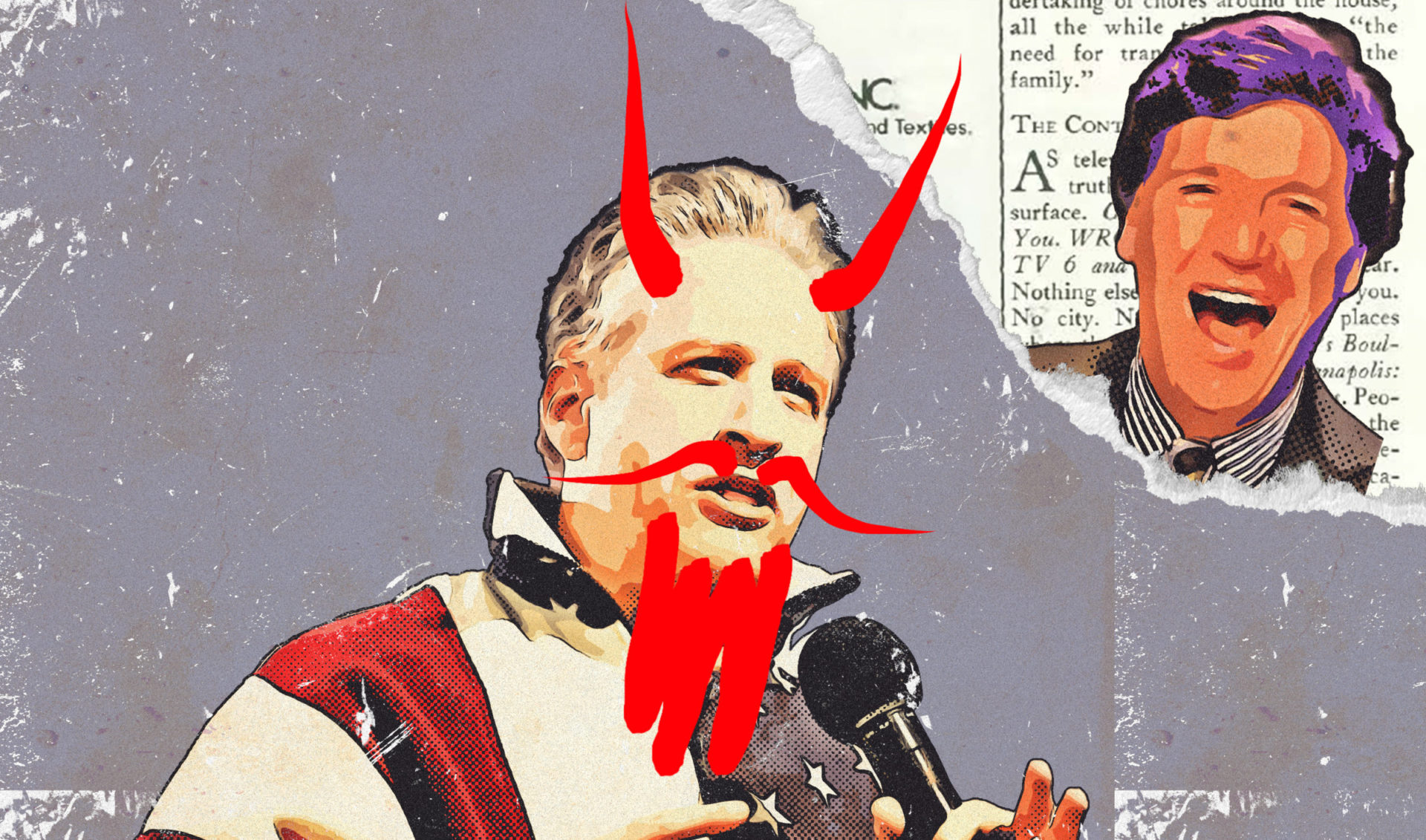
Jon Stewart has a dream where he walks out onto the brightly lit set of a new TV show. He has worked for years to build this show. It’s the answer to everything wrong with the news media.
For decades, Americans were fed a news diet of mass-produced garbage. O. J. Simpson, Monica Lewinsky, endless coverage of the Laci Peterson disappearance … hour after hour of filler. Talking points and “spin rooms” and canned zingers. Presidential aspirants doing eighth-grade debate theater. It was empty both-sides centrism. It didn’t speak to what mattered. It staged fake confrontations with powerful people to protect them from real accountability.
On this new show, yes, figures from across the political spectrum come to argue. But now it’s only real disagreement about the issues that matter to real Americans. No more treating politics like a staged wrestling match, only authentic single-warrior combat.
And the show does real reporting too, hard-hitting exposés on the issues other shows ignore. Reports about the billionaires who lined their pockets on the opioid crisis. Reports about warmongering elites lying so they can send working-class kids to die across the world. Reports about ideological indoctrination in public schools.
Gone are the manufactured news cycles on gaffes and the horse race. This show doesn’t let politicians duck behind talking points, but makes them say where they really stand on the issues. Gone is the view from nowhere, which was just a cover for manipulative slant. The host tells you straight what he really thinks and why it matters.
The old world of journalism is finally dying and this is the new one. Corporate shills didn’t think it could make money — and they didn’t want it to. They didn’t believe Americans would watch this. They didn’t believe in Americans at all.
But people are watching, by the millions. It’s raking in money hand over fist. Jon Stewart was right and the suits were wrong.
He saunters onto the set. He is ready to take his seat.
Only then, like Scrooge in the graveyard, does he see the name on the host’s chair. It isn’t him. It isn’t Stephen Colbert. It isn’t even Brian Williams. It’s a name from his past, a name that sends a chill down his spine and turns him pale. In his mind he hears a high-pitched whine and smells the sickly whiff of fresh bowtie.
How did Jon Stewart’s dream become his nightmare?
The problem was that he misunderstood what made the monolithic mass media world a financial success. He was convinced that you could keep all the business structures basically the same, and just replace the media’s phony reality with an authentic one. There would still be one huge audience, but now instead of being forced to crowd around a trough to guzzle slop, they would join together as one to break bread.
And nobody would have to worry about the money. The meal would be so nourishing, the conversation so lively, the feast so grand, that that part would just work itself out.
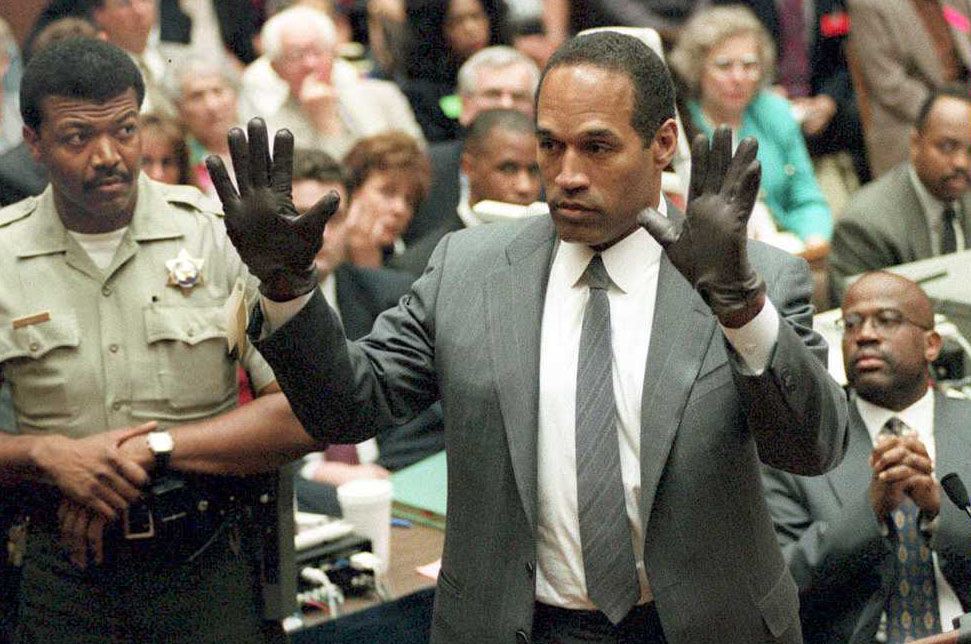
Stewart in his heyday was a man before his time. He wasn’t just a prophet of the new world to come; he was its chief architect. He would pioneer everything that made it work.
And he was dead wrong, too. In the world he was building, there would be no grand feast. As he tore down the pillars of the phony old consensus reality, he was laying the foundation for authentically fanatic alternate realities.
In our bizarro world, Jon Stewart’s fantasyland is real, and its king is none other than Tucker Carlson.
Even for those of us who lived through it, it is difficult to remember or explain what postwar America’s mega-saturated media monoculture was like, and how dramatic the shift away from it has been.
In the Nineties, the American mind was drenched in carefully constructed corporate messaging conveyed by a never-ending torrent of ephemeral media — countless TV channels, newspapers, magazines, and radio shows. Catchphrases, brand logos, product placement, and celebrity gossip were the psychic detritus. We were all swimming in it, and it was about nothing, nothing except itself.
Jon Stewart was not an activist when he took over The Daily Show on Comedy Central, a trifling basic cable channel, in 1999. But as a comedian he had a feel for the absurd, and nothing had grown more absurd in his mind than TV journalism, suffused with spin, fake debates, soft interviews, and celebrity politicians.
If you weren’t tuned in to the zeitgeist when the show mattered — roughly spanning the 2000 election to the Global Financial Crisis — here’s a refresher.
Stewart’s Daily Show was structured like a standard half-hour news show mixed with a talk show. It opened with an anchor at a news desk offering a quick rundown of the day’s top headlines. He then handed the show off to correspondents, who offered analysis from the studio, or produced on-location reported story segments in the style of weekly newsmagazine shows like 60 Minutes. Finally, the anchor interviewed a single subject at the anchor’s desk, in the style of Johnny Carson or Jimmy Kimmel.

The twist: It was fake. The rundown was actually a series of jokes about the headlines. The correspondents interviewed real people about real stories, but the setup was a gag, the correspondents acting in character to see what reactions they could get. And the whole thing was broadcast before a studio audience, who giggled and hooted and hollered like they were on Springer.
If you watched a field segment in the Stewart era and thought the correspondents were mocking real people, you were missing the point. They were making fun of themselves, their own characters. Each one was a send-up of a particular TV-journo type.
Rob Corddry, feigning ludicrous outrage at minor annoyances, was spoofing John Stossel’s blowhard “Give Me a Break” segment from 20/20. Stephen Colbert, the ultimate self-serious straight man, was aping Stone Phillips and Geraldo Rivera. “He’s got this great sense of mission,” an out-of-character Colbert said of Geraldo. “He just thinks he’s gonna change the world with this report.”
The brand Stewart had inherited was dedicated to little more than wacky jokes and pop-culture infotainment. Stewart would turn it into a tightly written, ironic ongoing commentary on politics and journalism. It became less about the news and more about news itself. It was about the pretensions and foolishness of the doofuses who said they were doing the real thing.
And the clips. The clips!
The feature that really made The Daily Show famous was its masterful use of archival video clips to reveal the hypocrisy of the chattering classes. Stewart would set his target on some party shill or professional talking head being condescending, self-important, dishing out blame, kissing whatever ring he’d been paid to kiss. And then the show would play a clip of the same talking head’s appearance on a C-SPAN 3 four-in-the-morning call-in show from ten years ago, back when he’d been paid to kiss another ring, saying the exact opposite thing.
There was a clip, there was always a clip. And our righteous host would send these hacks packing.
Through all this, certain public figures would be transformed into storylines with narratives and characters, with inside jokes and recurring bits. The media’s storytellers became the subjects of a theater of the absurd. It got so that when certain figures would show up in a segment, you knew you were about to witness them receive their just comeuppance, a great spectacle of spilled archival blood. The audience would titter in excited anticipation.
It was a delight to watch.
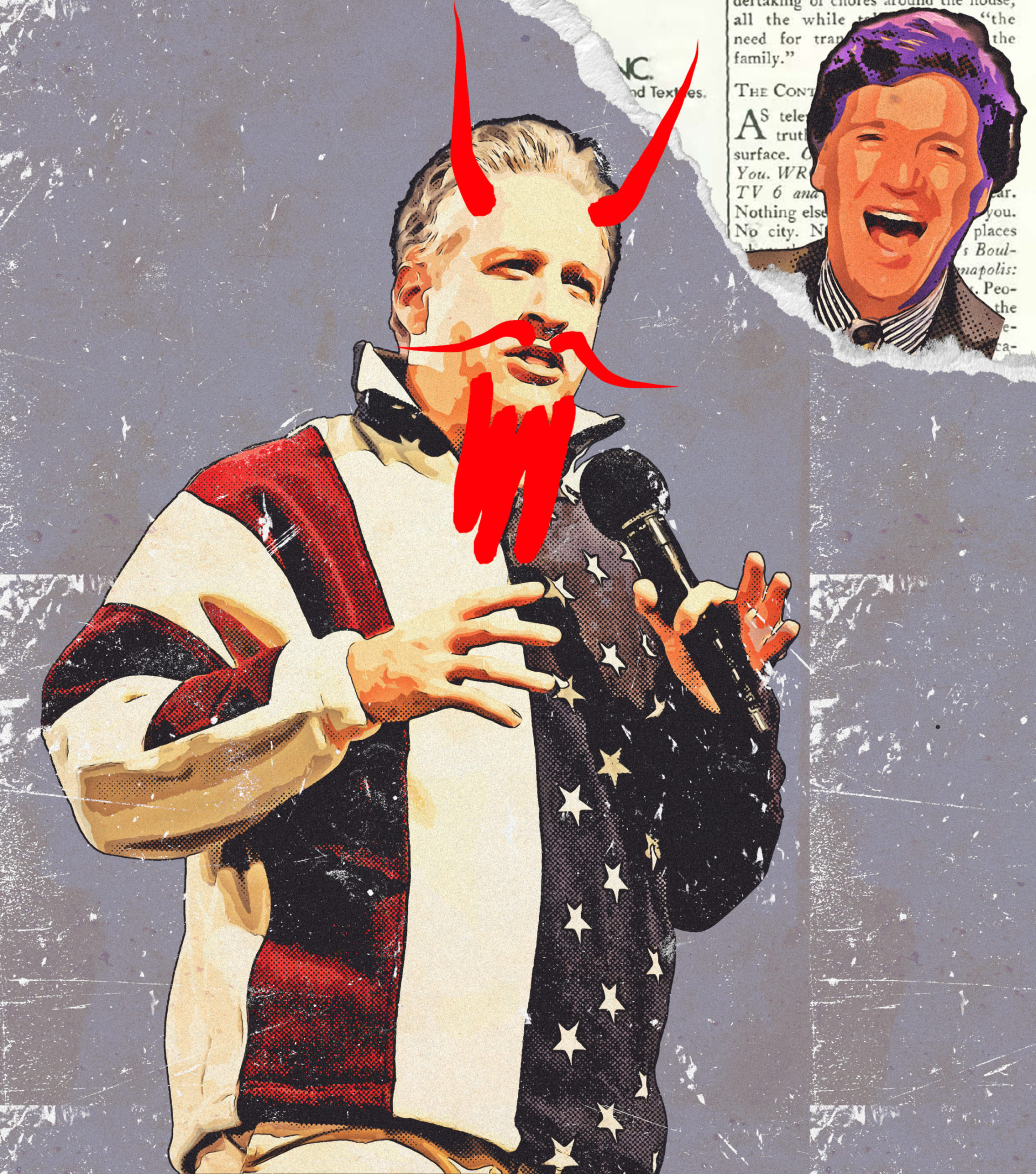
And it was a hit. In a glowing 2003 interview, Bill Moyers called Stewart “a man many consider to be the pre-eminent political analyst of our time,” a status he would enjoy for a decade.
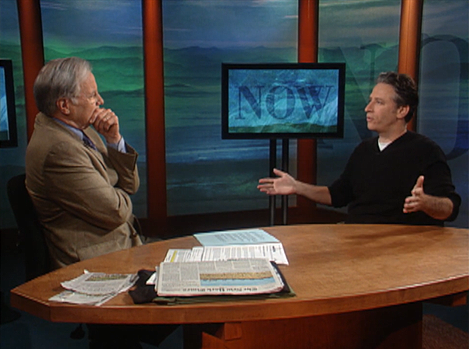
But there was always a tension in the enterprise, a risk that in taking down these bloviating figures, his own head would grow too big. And the risk was made worse because, strangely, Stewart never understood the source of his success. At least, he acted like he didn’t.
At the heart of his crusade, as he saw it, was a fight with media’s corporate overlords over whether news had to be dumb to make a buck. Stewart had no desire to just make another TV show. At a time when most political comedy was aimed at personal quirks, gaffes, and scandals, he maintained, like his hero George Carlin, a high view of comedy as an art form for social commentary.
But, as he retells it, the suits believed that to be profitable, a late-night show had to focus on pop culture. Earlier this year, talking about how he came to The Daily Show’s helm, Stewart recounted what he said to them: “Let’s make a deal. Let me do the thing that I believe in. And if it sucks and it doesn’t sell you enough beer, you can fire me.”
With a crack writing team, a distinctive vision, and a stable of generational comic talent, The Daily Show sold beer and then some. By the end of his run he was personally earning $25 million a year, making him not just the highest-paid host on late-night television but possibly in the entire news business — higher than Letterman, than Matt Lauer, than Brian Williams. “We developed the thing that we believed in and the audience showed up.”
If you build it, they will come. The corporate idea that Americans wanted canned news instead of viewpoint journalism and hard-hitting interviews of politicians was a lazy excuse masquerading as a market analysis.
Call it Stewart’s Content Theory: The real reason conventional news sucked was, well, because it sucked. It was bad because nobody had tried to make it not bad. Maybe producers didn’t have the guts, maybe journalists were addicted to access, maybe it was just the inertia of the whole system. Maybe they needed a prophet to help them see the light. Whatever the case, the answer was simple: Instead of choosing to be phony and bad, they should choose to be real and good.
Nothing was stopping reporters from flipping this switch. If you had an authentic viewpoint that took the audience seriously, presented with boldness and creativity, you could both entertain and inform, and find enough advertisers to pay for it all. After all, The Daily Show did.
So if it was that easy, why wasn’t everyone else doing it too?
There was an alternative theory for why news was so terrible: The structure of the news business itself dictated what journalism could be.
The growing shallowness of American journalism had a surprising source: the fairness doctrine. The 1949 regulation is remembered today as a “both-sides” mandate, requiring that TV and radio broadcasters who gave air time to one side of a public controversy had to give equal air time to the other. But it had another, largely forgotten component: As a condition of their license, it required that broadcasters air news coverage in the first place. For the first several decades of television, corporations thus viewed their news divisions as a public service, a necessary cost of maintaining their overall brand, and a checkbox to ensure their legal right to operate.
As early as 1961, American historian Daniel Boorstin had raised the alarm about how the mandate to churn out news was warping our media diet. He coined the term “pseudo-event” to describe things that happen simply in order to be reported on. For Boorstin, the driver of pseudo-events was a reversal from gathering the news, as events dictated, to making the news, as a standardized product on a schedule.
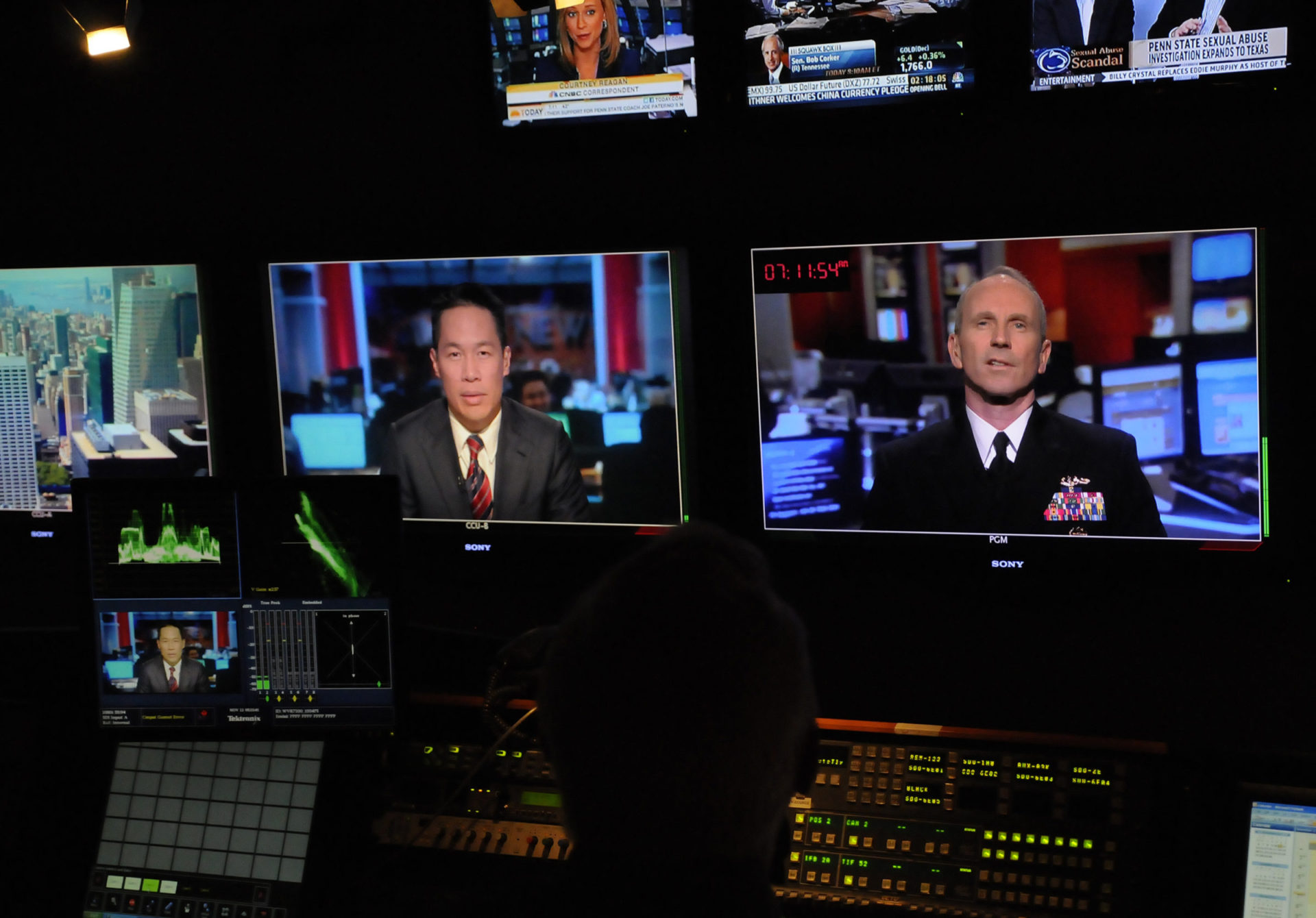
The larger your news-making enterprise, the more events you needed to have to fill airtime. When you ran out of events of true public note, you turned to pseudo-events: interviews, press conferences, and other PR exercises, plus interpretations, analysis, and opinion about the same. Thus the mass-produced phoniness Stewart would lampoon.
Paradoxically, after the end of the mandate to make news there was actually an increase in coverage.
In 1987, the Federal Communications Commission abolished the fairness doctrine. But at the same time, cable was rising and content needed to be produced on an even greater scale. With greater competition among channels, and no more law that rationalized tolerating losses on news, the industry insisted that news divisions turn a profit like any other.
But producing the news had huge fixed costs. You needed studios, journalists, and correspondents around the globe, regardless of how many hours of coverage you aired. And so the simple solution to generating profits was to spread those costs out, producing more news across more channels within the same corporations.
The strategy worked. After the repeal of the fairness doctrine, the production of TV news exploded, from an hour or so a day on each of the big three networks to continuous, 24/7 coverage across multiple networks. NBC News had been losing $100 million a year when GE bought the network in 1986. By 1998, the division earned $200 million in profit, drawing revenue from its ratings-dominating broadcast programs Today, Dateline, and NBC Nightly News, its cable channels MSNBC and CNBC, and an online news venture with Microsoft.
Nineteen ninety-nine was what we might call the Year of Peak News, the year this media culture and the industry driving it were at their zenith. It was the peak of the Lewinsky plotline in the form of the Clinton impeachment trial, and the peak of the self-fueling pyre of journalistic importance surrounding it — the more that TV covered it, the more important it became. It was the year that the respected journalists Tom Rosenstiel and Bill Kovach, in their book Warp Speed, warned that competition for attention and ad revenue had created an alternative media reality entirely separate from what really mattered for the country. It was near the point that more Americans were working in media than ever had before or ever would again — industry employment peaked at 1.6 million in July 2000 and never returned.
Nineteen ninety-nine was also the zenith of a powerful counter-cultural backlash. The problem wasn’t just the news. It was how the entire consumer culture powered by mass advertising was rotting our souls and immersing us in unreality. Nineteen ninety-nine was the year American Beauty won Best Picture and The Matrix invited us to take the red pill. It was the year that Fight Club warned, “Advertising has us chasing cars and clothes, working jobs we hate so we can buy shit we don’t need…. We have no Great War. No Great Depression. Our great war is a spiritual war.” Call it the Year of Peak Fight-the-System.
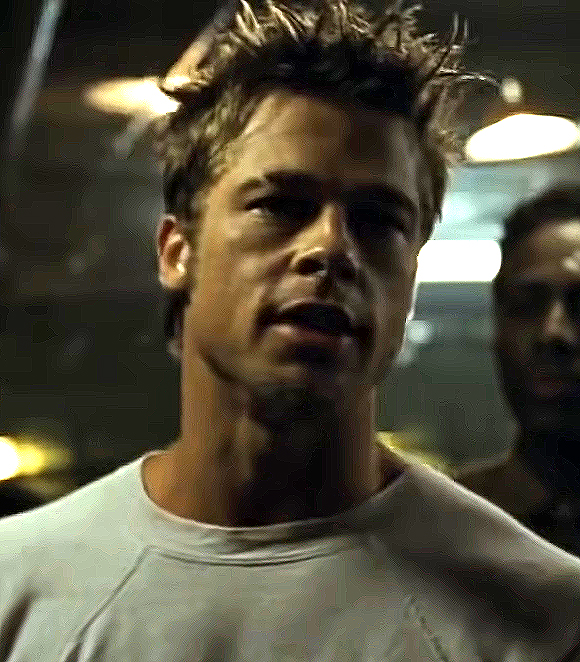
Would reform be enough, or did there need to be revolution? In 1999, an influential group of activists argued that nothing could change until mass advertising’s grip on the news industry was broken.
That year, Kalle Lasn published his landmark book Culture Jam. Lasn, a founder of Adbusters magazine and a former market researcher, had come to see the stranglehold of corporate media as the meta-problem making progress impossible for left-wing movements. In the 1980s, he had begun trying to work within the system, buying short environmentalist and anti-consumerist commercials, only to be almost universally turned down by the networks.
Station owners’ reticence made sense. Newspapers, television, and radio all ran on advertising. Advertising existed to spread corporate brand messages, and its value was based on how much consumption it drove. As Lasn had shown, you couldn’t even buy airtime for a fair hearing of ideas that ran counter to the interests of advertising. Authenticity was impossible within the system. American culture had become a corporate product, sponsored by advertising-based mass media.
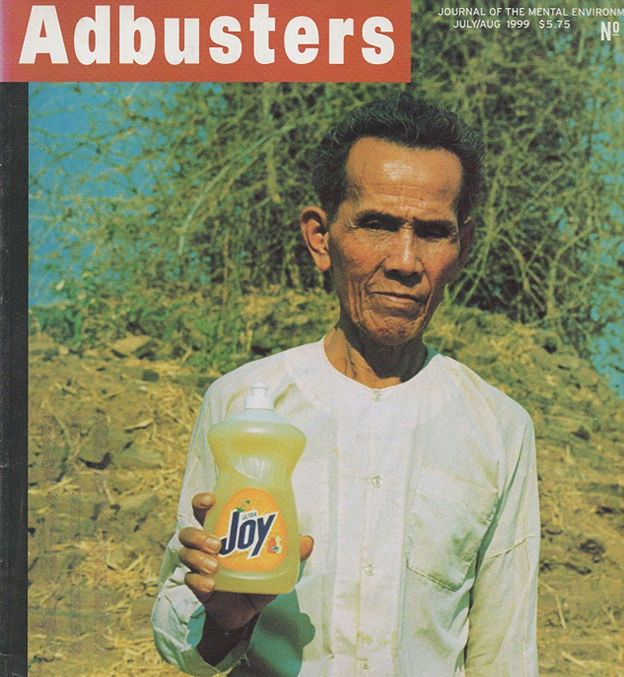
Lasn was joined by Naomi Klein, whose book No Logo was also published in 1999 — days after the “Battle in Seattle,” a protest against the World Trade Organization, began in earnest. All blamed the ravages of free trade and global finance on the corporate takeover of the public square. They proposed a set of “culture jamming” tactics to push back — protests and petitions, counter-marketing, brand hijacking, “subvertisements.”
Call this Lasn’s Structure Theory: The reason news sucked was that the economics of the news business required it to suck. The suits were right after all.
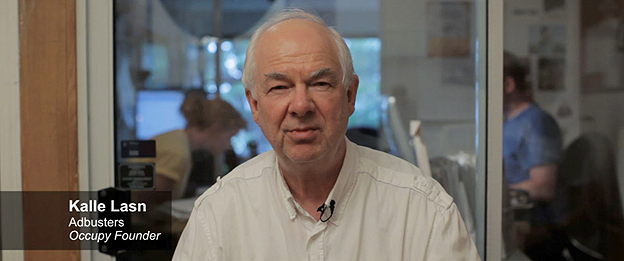
It’s hard to remember how pervasive the structural critique was in the Nineties, and to appreciate how thoroughly it has vanished from public life. Pretty soon you stopped hearing about how advertising and brands and consumerism were eroding civic life. Lasn’s Structure Theory faded away.
Perhaps that had something to do with that other notable event from The Year of Peak News: Jon Stewart’s ascension to the Daily Show throne.
On the surface, Stewart, with his counter-establishment, anti-corporate message, sounded a lot like these activists. But Stewart’s Content Theory was that you could stage a revolution against the system from within.
The showdown between legacy media and Jon Stewart’s real fake news insurgency reached a head in October 2004, when he sought out a duel with a show that stood for everything he reviled about political journalism.
The show was CNN’s Crossfire. It featured one liberal host and one conservative host who would debate the issues of the day. Usually they were joined by one liberal guest and one conservative guest who did more of the same. These talking heads recited their talking points, all nice and neat. Afterward they probably all headed out to the same cocktail party.
From the start of the segment, you could tell that the hosts didn’t stand a chance. They were dutifully antagonistic with Stewart, but they were tired old welterweight champs who didn’t see the new generation of fighter standing before them in the ring.
Stewart was as funny as ever, but this time without the ironic grin. His face was stony. He was mad.
“We need help from the media, and they’re hurting us,” Stewart implored the hosts. “It’s not so much that [this show] is bad, as it’s hurting America.”
“Let me get this straight,” the liberal host replied. “If the indictment is … that Crossfire reduces everything … to left, right, black, white. Well, it’s because, see, we’re a debate show.” “We have each side on, as best we can get them, and have them fight it out.”
Stewart would have none of it. “After the debates, where do you guys head to right afterwards?…. Spin alley.” He was talking about how, after formal debates, reporters would interview campaign flaks whose job was to argue why their guy had won, regardless of what had actually happened. “Now, don’t you think that, for people watching at home, that’s kind of a drag, that you’re literally walking to a place called ‘deception lane’?”
It wasn’t real debate — it was fake. “What you do is not honest, what you do is partisan hackery.” Instead of helping the people, “you’re helping the politicians and the corporations…. you are part of their strategies.”
In the countless retrospectives that have been written on the Crossfire showdown, which became one of the defining media moments of the 2000s, much has been said about Stewart’s hypocrisy. One of the hosts pointed it out: “You had John Kerry on your show and you sniff his throne and you’re accusing us of partisan hackery?” Stewart ducked this lamely: “You’re on CNN. The show that leads into me is puppets making crank phone calls. What is wrong with you?”
But what matters isn’t that Stewart was a hypocrite. It was how masterful The Daily Show was at leveraging this double standard.
In a monologue during the U.S. invasion of Iraq, Stewart joked that “our show obviously is at a disadvantage compared to the many other news sources that we are competing with…. For one thing, we are fake.” But of course the subtext of The Daily Show was that all TV news was fake news, and everyone else was just lying about it. Being honestly fake wasn’t a liability. It was a huge asset.
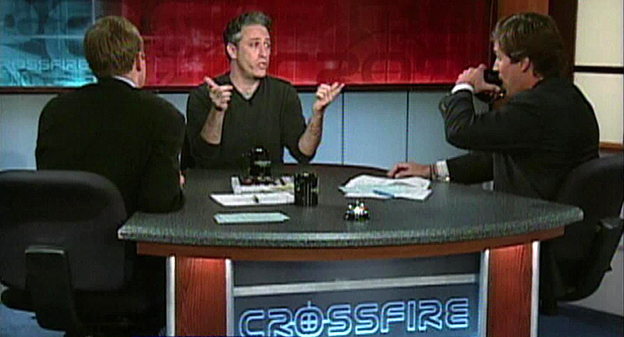
The Daily Show really was news. It covered the basic facts of the stories of the day. Its viewers were about as well-informed as those of broadcast or cable TV news. And surveys showed its newscasts were as trusted as many mainstream media sources.
And because it made no pretense of “fairness” or “objectivity,” it had an enormous advantage in competing for the eyeballs and allegiances of its young audience. Because its only explicit loyalty was to the laughs, the show could ignore “the news cycle” and focus on the stories that hit the right notes for its audience. Even as Jon Stewart fought a world of empty spin, he pioneered a model of television news where you didn’t need to manage the reporting, the sources, or the production of compelling televisual imagery. By wresting control of the context, you could bend it to your will and tell the story you wanted to tell.
The genius of The Daily Show wasn’t that it was great in spite of everyone else sucking; it was great because everyone else sucked. As long as there was an endless supply of garbage on hand — and boy, was there — you could do a show that was just about the garbage. And, perversely, you could be more successful talking about the garbage than making it.
Stewart was a critic of the system, and also its greatest dependent. Did he really not get this? For a moment in the Crossfire showdown, it seemed like he did: “The absurdity of the system provides us the most material…. the theater of it all.”
Three months after the matchup, Crossfire was canned. CNN’s new president, Jonathan Klein, said that he wanted to move the network away from “head-butting debate shows” and toward “roll-up-your-sleeves storytelling,” adding, “I agree wholeheartedly with Jon Stewart’s overall premise.”
But was the new model for news really just going to be a more earnest, informative version of the old?
You didn’t even have to listen to the Crossfire segment to know that it wasn’t just a drubbing but the birth of a new world. You could see it on the hosts’ faces. The establishment had lost the plot.
The liberal host, Paul Begala, kept trying to change the subject. On his face you could see the dumbstruck look of the compliant citizen murdered on the roadside by Anton Chigurh in No Country for Old Men. After Crossfire was canceled he never hosted his own television show again.
The old world was dying. You could ignore this and double down, or you could learn how to stand outside legacy media — and wield this to your advantage.

The conservative host tried valiantly, jousting like he was untouched. But as the segment wore on, his voice kept going higher, he sounded desperate. “I think you’re a good comedian,” he told Stewart. “I think your lectures are boring.” But by the end of the segment, you could see the wheels turning in his head.
His name was Tucker Carlson.
The Daily Show was a pioneer of the above-it-all style. But its weapon was not pointed parody alone.
When the Global Financial Crisis struck, Stewart was still at the height of his influence. Once again he saw a case of the media’s interests running opposite to the people’s. He was ready for another showdown.
In February 2009, CNBC pundit Rick Santelli had delivered an angry rant against a government bailout for “losers’ mortgages.” He floated the idea of holding a “Chicago Tea Party,” where “derivative securities” would be dumped into Lake Michigan. The diatribe would soon ignite the populist, right-wing Tea Party movement.
Stewart was righteous with indignation. Two weeks later, he aired clip after damning clip of CNBC pundits offering horribly wrong investment advice leading up to the financial crisis. He topped it off with a monologue indicting the chumminess, corruption, and self-dealing of finance and financial journalism.
One of those pundits, Jim Cramer, the host of CNBC’s Mad Money and the most famous financial pundit on TV, would defend his record on his show and write an op-ed calling for “a real debate.” Stewart then broadcast a patient and lethal blow-by-blow of Cramer’s advice to buy what would turn out to be rotten stock in Bear Stearns.
In March, within days of the stock market bottoming out, Cramer showed up for an interview on The Daily Show. In the segment — billed in news outlets as “Stewart vs. Cramer,” like a boxing match — Cramer got the treatment the audience knew was coming.
But there was a new twist. Usually, The Daily Show would air archival clips framed by Stewart’s solo narration. This time they were being deployed in real time against a subject who was sitting right there in the guest chair. Stewart would say something about Cramer’s chummy relationship to the financial system. Cramer would dodge and weave and try to recontextualize. And then Stewart would call out, “Roll 210,” and out would come some obscure footage of Cramer himself from his hedge fund days, peddling the very kinds of shenanigans that had led to the crisis. Over and over. It was devastating.
For the first time, facts had caught up to spin. Rather than leaving it at great gotcha TV, Stewart used the clips and his back-and-forth with Cramer to fuel a compelling cri de coeur about corruption on Wall Street.
Just like the Crossfire appearance, it was a beautiful thing to behold. How were the Daily Show staff so damned good at this? The question bedeviled Stewart’s competitors — one profile noted that “how the show’s producers find the source video for these elaborate montages has been a bit of a trade secret.”
What had created a culture of “just talking on TV without any accountability,” as one Daily Show writer put it, was not only the sheer volume and speed of the news. It was this true fact that will sound insane to anyone under the age of thirty: People on television reasonably assumed that no one would hear what they had said ever again.
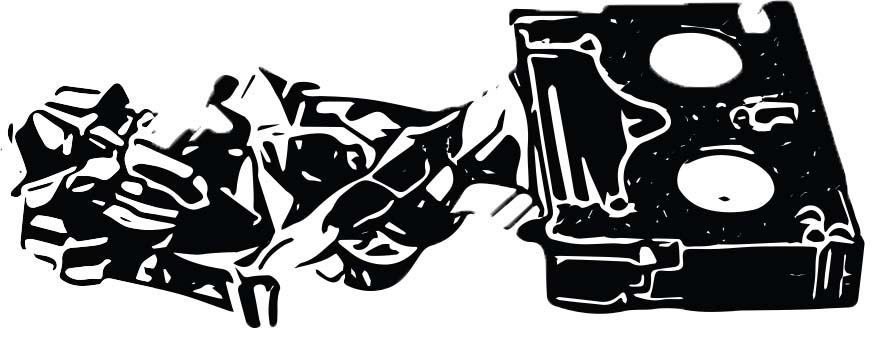
As essayist Chuck Klosterman records in The Nineties: A Book, the key characteristic of twentieth-century media was its ephemerality. You experienced it in real time and internalized what was important and what it felt like. Then you moved on. “It was a decade of seeing absolutely everything before never seeing it again.”
People used to argue with their friends about the plot of a show or what the score had been in the ball game because, well, how were you going to check? Unless you had personally saved the newspaper or recorded it on your VCR, you would need to go to a literal archive and pull it up on microfilm.
TV news was even shakier, as networks often recorded over old tapes. Some of this footage only exists today because of the obsessive efforts of one Philadelphia woman who recorded news broadcasts on 140,000 VHS tapes over forty years.
And so, if you were a pundit or a commentator or a “spin doctor” PR flak, you could say whatever suited your needs at the moment, or even lie with impunity — as long as your lie did not become its own pseudo-event. Your lasting impact was whatever stuck in viewers’ heads and hearts. And if you changed your tune in the months or years afterwards, who would remember?
The Daily Show would remember.
The explosion of live broadcast and cable news had created a new, completely under-valued resource for whoever thought to harness it: catalog clips. Soon, new digital technology could preserve content in amber, allowing for its retrieval, repurposing, or referencing at any time.
Another signal event from 1999, the Year of Peak News: The first digital television recorder, TiVo, came onto the market. At a time when news networks sent out old footage by postal mail, the TiVo made it possible for Daily Show producers to record, catalog, and comb through hundreds of hours of footage a week. Their process became substantially more powerful in 2010 with the deployment of a custom, state-of-the-art system that both captured footage and converted its audio to text, allowing producers to search for just the right clips across the entire accumulated archive.
The Daily Show always portrayed itself as the David to the news establishment’s Goliath. But in the showdown, Cramer pointed out the advantages the show had when it came to the production mechanics of filling air time. “We’ve got seventeen hours of live TV a day to do…. I’ve got an hour, I’ve got one writer, he’s my nephew…. You have eighteen guys.”
Stewart liked to claim that they were just jokers, but really the joke was on everyone else. The Daily Show had figured out how to produce a real, high-quality newscast after all — without having to do any of its own reporting. Under the “fair use” copyright exception for parody, the show could simply steal whatever content it needed from its competitors.
The evening news had to send its correspondents to exotic locales. Sure, The Daily Show would sometimes do the same. But it also had a recurring joke about using the studio green screen to do its “field” interviews.
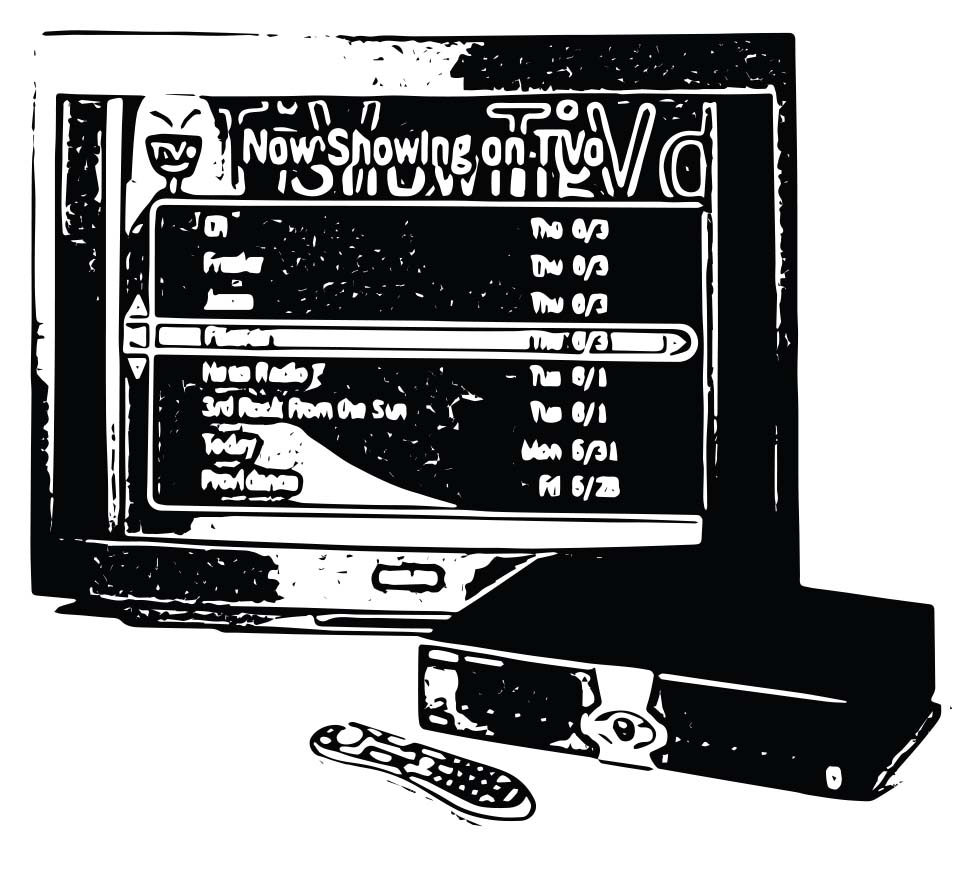
For legacy media, you needed to always be producing the news. The Daily Show’s incentives were reversed: It could dine out on a viral clip for weeks, and there was an ever-expanding universe of recycled material to work with and a bevy of writers to use them.
It wasn’t just the ironic style of the show, then, that allowed it to turn real people into characters in ongoing narrative arcs. It was their remarkable use of technology to build an ever-growing database of content. When Stewart later said, “We were parasitic on the political-media economy, but we were not a part of it,” he was only right about the first part.
Against spin and vacuity in political journalism, Jon Stewart harnessed the past as a weapon. It was The Daily Show, more than any other factor, that began the disciplining of American political culture with perfect digital memory.
Even as Stewart was turning the content and production models of legacy news into a joke, its revenue model was about to be destroyed too. In the 2000s, two major innovations on the Internet tanked the economic value of offering homogenized content to a mass audience.
In the Year of Peak News, there was only one game in town when it came to advertising. Producers of content, and advertisers along with them, were competing for as many eyeballs as possible. They were effectively trying to reach everyone. A publication made money based on how large a piece it cut out of this single massive pie.
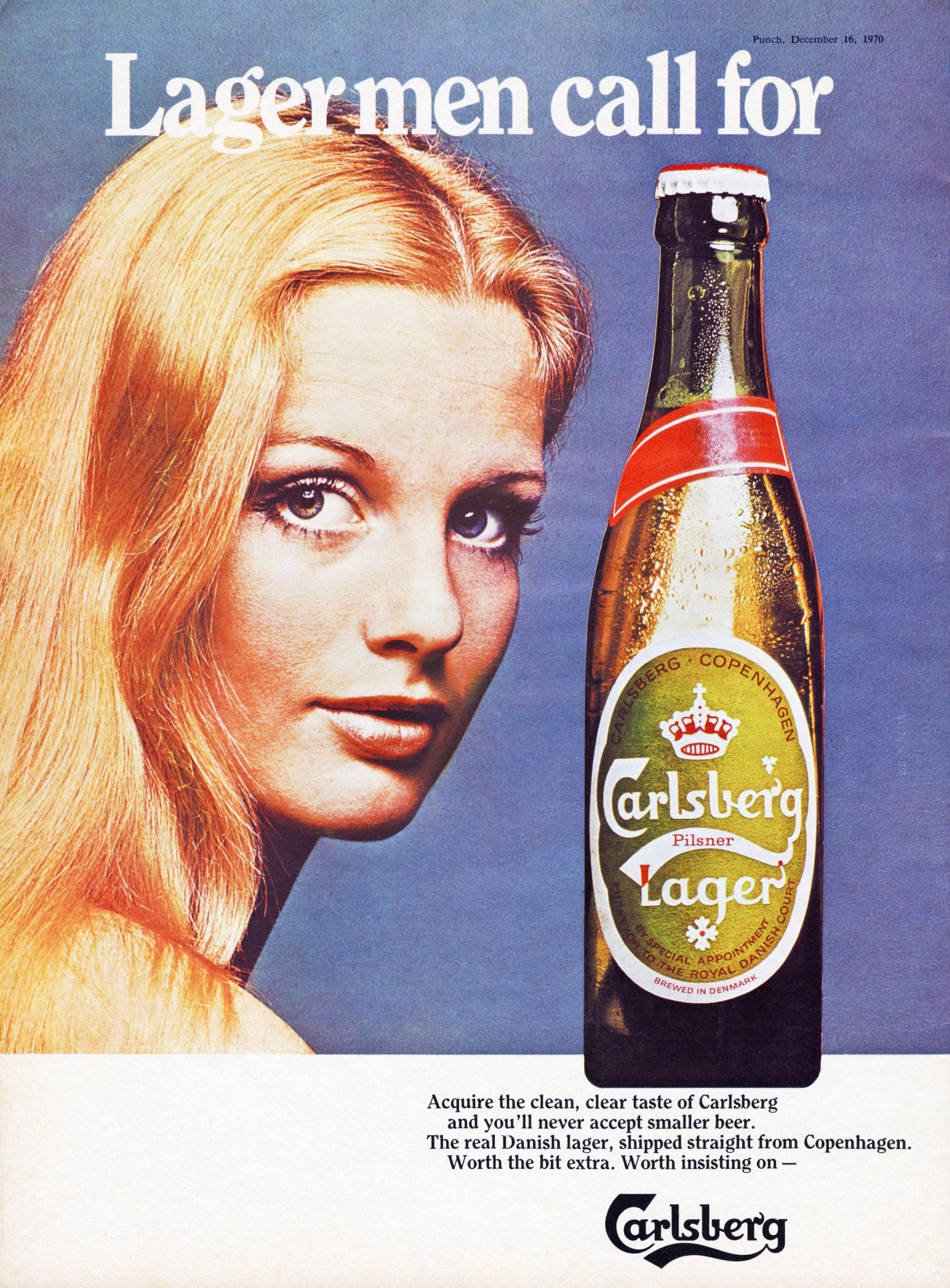
It is often said that what destroyed the legacy advertising model was the Internet, but that isn’t quite true. The Internet operated for many years without touching the mass advertising business. That giant would eventually be felled by Google, but initially the company refused on moral principle to make money from advertising. In a 1998 paper, the company’s founders wrote that search engines funded by ads “will be inherently biased towards the advertisers and away from the needs of the consumers.” Instead, Google sold licenses to other companies to use its search technology. But amid the pressures of the dot-com bust, the company would backtrack and pursue a new revenue stream based on targeted search ads, launching Adwords in October 2000.
During the aughts, the new personalized digital advertising business made mass advertising ever less valuable. For businesses, targeted ads were much more effective than ads aimed more or less at everyone, even with the existence of niche publications and demographic segmentation. If you were a sports memorabilia company, why target everyone who read Sports Illustrated when you could directly target people who searched online for old MLB tickets?
In the Year of Peak News, there was also only one game in town when it came to how consumers got their information. For half a century, if you wanted to know what was happening, you had to buy the paper or sit through eight minutes of ads during the nightly news. There was a seller’s market for information, and so producers could make money just by providing access. Even local newspapers thrived on this scarcity — decades of vital local journalism was funded in large part by readers who just wanted to know whether the Packers won last night.
Even in the early 2000s, the legacy media business model was still protected by this moat. Yes, the Internet existed, but the world’s information was mostly not online, and it was not well organized. Most of the content you saw on the early Web was not yet compiled automatically. In many cases, curation — adding and organizing content — was still done, quite literally, by hand. Even “cutting-edge” search services like Ask Jeeves, which advertised its amazing question-and-answer technology, had to employ legions of writers to help produce answers to queries. Because Web 1.0 offered roughly the same information abundance as before, legacy media maintained its monopoly on attention, and subscription and classified and advertising dollars kept flowing.
All this too would change as Google and others pioneered the technologies for automatically collecting, aggregating, and curating information online. A decade later, nobody was buying the daily paper to find out the Packers score. Now all you had to do to find out what was happening was open Google News, and you had your pick of headlines from a thousand different sources. Why would you pay for any of them now?
These were the two pillars of the new media world: Personalized digital ad tech was destroying the value of the mass audience. And automatic aggregation was making information superabundant, and so far less valuable.
Mass advertising soon declined while online advertising boomed. Newspaper ad revenue reached a historic peak of $49 billion in 2005 before plummeting to just $20 billion in the following decade. In 2010, online ad sales surpassed newspaper ad sales for the first time.
If the media world wanted to survive, it would have to figure out how to turn lemons into lemonade — how to make money from a narrow rather than a mass audience, and how to harness massive amounts of cheap information and create something valuable on top of it.
Our fearless hero was set to lead the way.
Would you be surprised to learn that Jon Stewart was a fan of Roger Ailes? Fox News, Ailes’s brainchild, is the news organization Stewart has most consistently complimented for its focus and skill. Over the years he has depicted Ailes as effective, “brilliant,” and evil. What made Ailes a visionary, Stewart thought, was his power to divine the most compelling narratives for his audience, regardless of what the mainstream media was focused on, and to then get the entire network on the same page.
Increasingly, Stewart wondered what it would look like to have a “Roger Ailes of veracity” — a network mind who was brilliant at producing high-caliber entertainment, but whose lodestar was not conservative politics but the most important practical issues confronting the country.
What Stewart had already achieved was to break open what media critic George W. S. Trow called “the context of no-context” — the way that you couldn’t understand why any story was covered on TV except that it was on TV.

The O. J. Simpson trial, the Monica Lewinsky scandal, the Laci Peterson case, Crossfire: None of them made sense as events of public importance for a great people. But they made perfect sense as great television.
If you watched American Beauty and Fight Club and The Matrix in the Year of Peak News, you probably felt that getting beyond this empty culture meant burning it down and replacing it with something brave, real, and true. But implicitly, this meant that it would have the same unified audience, the same mass audience, freed at last from slavery to soulless garbage.
The catch is that the mass and the garbage were one. The reason TV culture was so shallow was that it imposed over everything what Trow called the “grid of two hundred million,” that is, the number of Americans when he was writing in 1980. The business imperative was to grab as much of the television audience — singular — as possible. All content decisions flowed from this imperative.
Jon Stewart did not get this. He dreamed of a broad, hard-working, underserved middle of the country, hungry for the entertaining veracity he would produce. The idealized audience he often invoked was the silent majority of fundamentally decent Americans who were turned off by political extremism and partisanship for the sake of partisanship. In a 2002 interview he called this the “disenfranchised center” for “fairness, common sense, and moderation.”
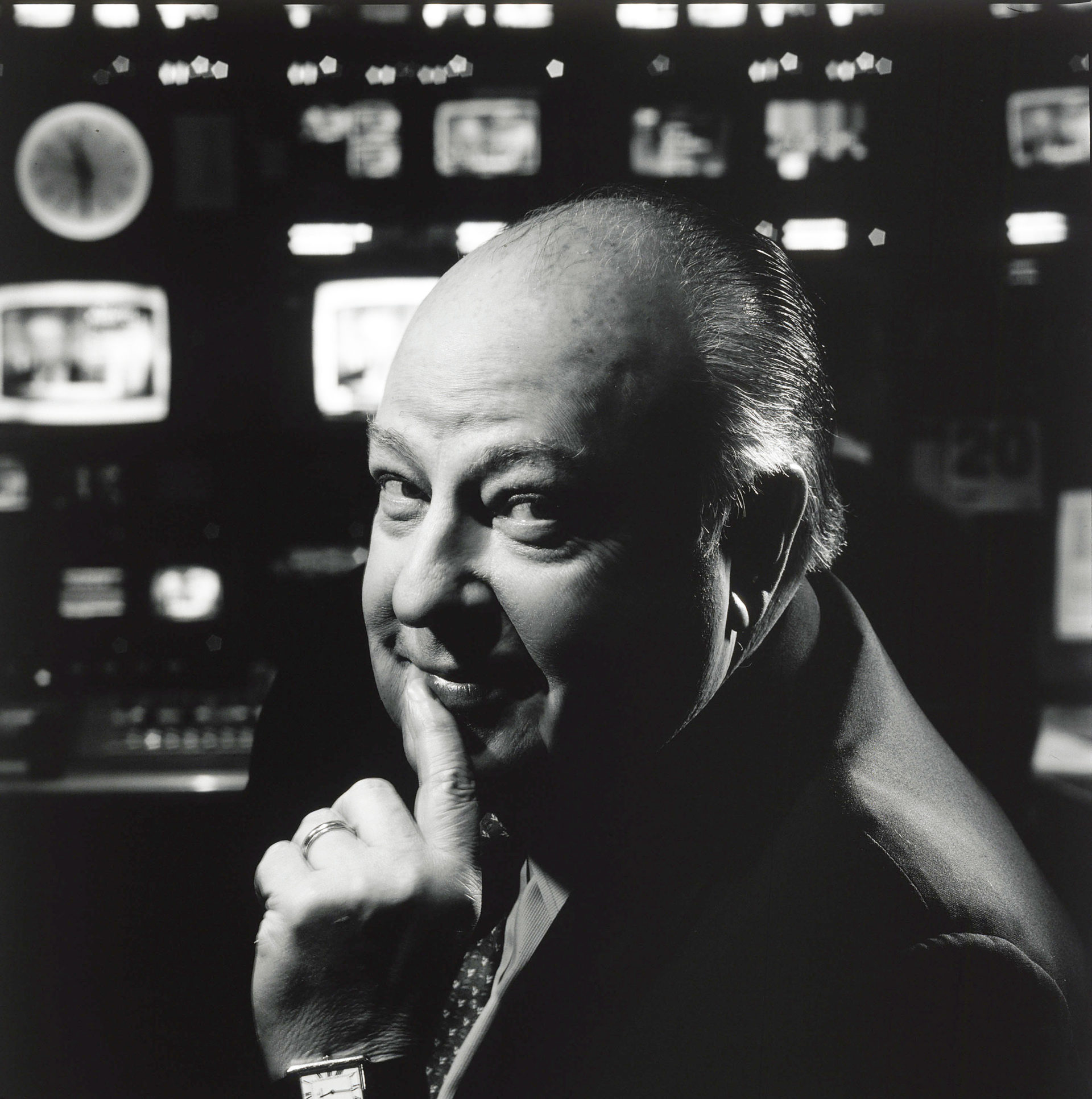
This might be a fair description of the 1999 broadcast TV audience, but it was not a description of Stewart’s own viewers. Pew Research found that The Daily Show had one of the most liberal audiences of any show on TV, beaten only by Rachel Maddow’s, and no show’s viewers skewed more high-income or high-education.
Roger Ailes did get this. The Fox News business model was not actually aimed at conservatives, but at newly deregulated cable. Ad-funded broadcast TV had rewarded achieving the biggest audiences possible. But cable rewarded having loyal, consistent audiences who would clamor for access to their favorite channels, giving owners leverage to negotiate the highest subscriber fees from cable providers. In 2021 Fox’s cable division generated $3.9 billion in revenue from fees and only $1.3 billion in advertising.
This business model meant cultivating ties with a particular niche, providing them content they would find enthralling, and eventually building identities around media brands. When Fox News launched, American conservatives were the biggest distinctly underserved niche. But MSNBC and CNN would eventually follow in their footsteps, for the same reasons.
As in so many other things, Stewart was also a master innovator of what he claimed not to want: building a devoted niche audience.
When the mass audience produced by advertising melted down, the innovations in style and production that Stewart had pioneered were a ready-made answer for this crisis. They provided a template for how to be successful not with a mass audience but with a loyal fragment — by replacing the culture of mass media with meta-commentary on it, and the costly production of original news reporting with an efficient repurposing of others’ work.
But even this description undersells what made The Daily Show unique, and why it seemed to wax even as all other TV news waned. The real audience that sustained him assembled where all audiences assemble today: online.
Stewart understood that converting a loyal audience into a media-business success is not just about getting eyeballs in front of the set (the Friends model), or even getting people to pay you every month (Patreon and Substack). It’s about getting people to be personally loyal to you, to identify with your brand.
You could tell that Stewart understood this because of the way he used clips of his own show. In legacy television, you would never give away your content in a way that couldn’t be directly monetized, from which you weren’t getting a licensing buck or a bump in the Nielsen ratings. But The Daily Show just gave their stuff away. They knew that the Internet would help build loyalty — and eventually an audience — that would make Stewart powerful.
The Daily Show was the first TV show whose clips regularly went viral via forwarded emails, discussion forums, and shared BitTorrent links. Even as The Daily Show often had to send its interns to archiving services to pick up physical tapes of other shows, it was one of the first to host specific shareable clips on its website, alongside full episodes. It was the first whose producers grasped how free clips online could drive, rather than cannibalize, viewership numbers. Stewart’s appearance on Crossfire may have been the first piece of national political journalism to go viral online. And all this got underway before YouTube, whose first video was uploaded six months after the Crossfire showdown.
The audience of The Daily Show, and eventually its offshoot The Colbert Report, was thus significantly larger than what the TV ratings alone revealed. It was more personally loyal to Stewart and Colbert. It was an audience that shared clips, talked about them on Twitter and Reddit, and bought books. It was an audience that crowdsourced rides and couchsurf spots to show up in the hundreds of thousands for their satirical “Rally to Restore Sanity and/or Fear” in 2010. It was an audience that donated over a million dollars to a Stewart and Colbert–organized Super PAC, as a bit. These shows did not have a passive television audience, but one activated and organized by, with, and through the Internet. As Colbert said of the Rally: “They were there to play a game along with us.”
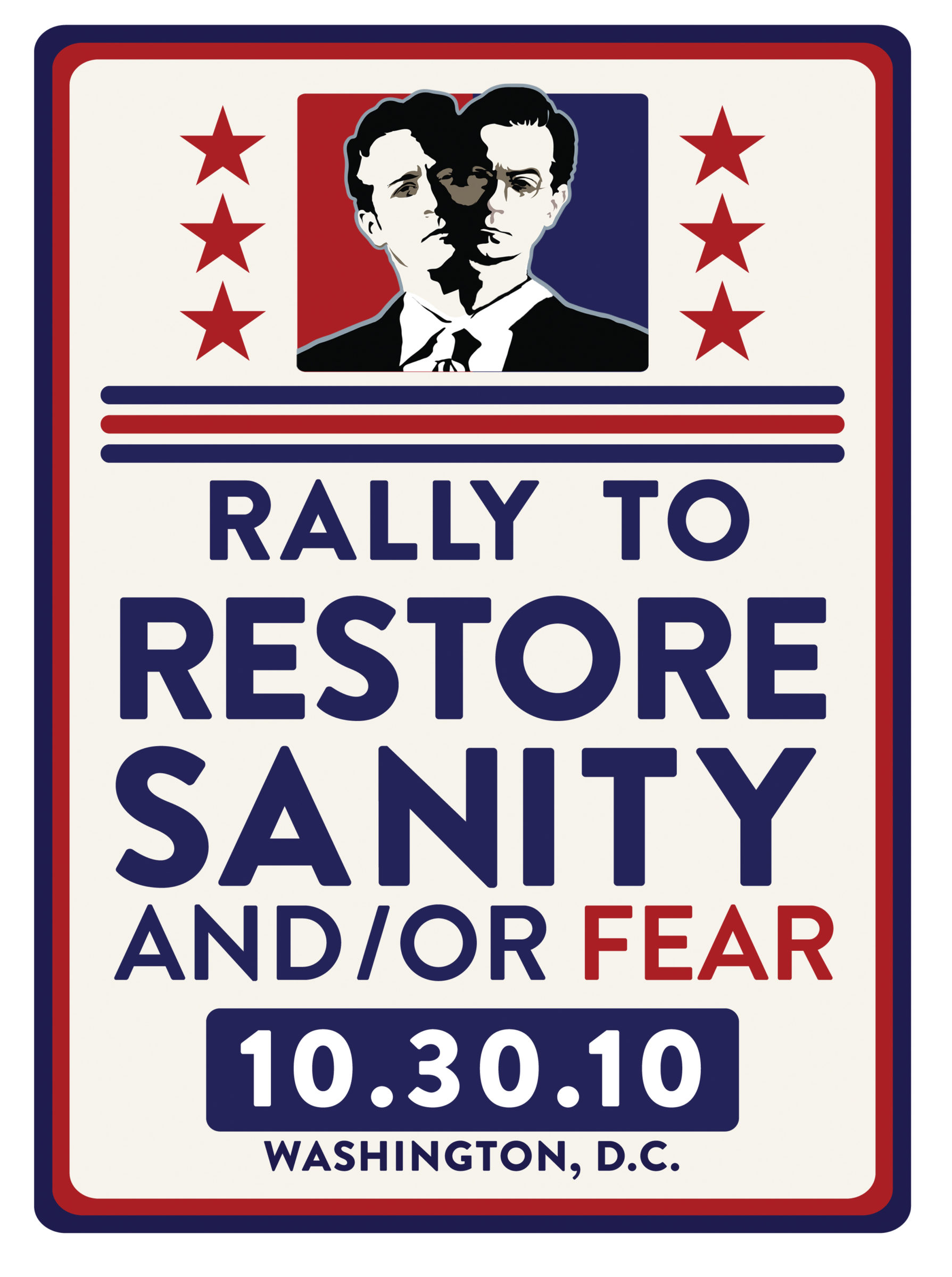
Contrast this with, say, David Letterman’s show, initially a rival to The Daily Show. Letterman had a cult following, and you could buy his merchandise and books. But the point of all that was to get you to watch the show. Everyone who bought Letterman’s Top Ten books watched the show.
But with The Daily Show, you could just watch clips when someone shared them, and not bother with the show. The books and rallies weren’t marketing gimmicks; they were a whole new ecosystem, of which the show was just one format. It’s hard to think of an earlier TV show that had such a loyal following of people who did not actually watch it on TV — Oprah had an empire, but her fans mostly watched her. Every show before Stewart’s you could understand as a TV show. But The Daily Show was an audience first and a TV show second.
You didn’t just watch The Daily Show; you subscribed to its worldview. Stewart hadn’t figured out how to build a revenue stream around subscriptions yet, but others soon would.
At first blush, the idea of audience-sponsored journalism sounds neither new nor worrying. Newspapers before the mid-nineteenth century were partisan outfits run on subscription revenue, not advertising. And surely news consumers have purer motives than faceless corporations do — especially if their support isn’t even commercial but philanthropic, like sponsoring a Patreon, public radio, or The Atlantic.
This intuition is wrong on two counts.
First, having to sell content to audiences — rather than selling eyeballs to advertisers — transforms the incentives reporters face. Advertisers like positive stories that put you in the mood to buy stuff, while readers and viewers respond more to fear- or anger-inducing stories. Other than on stories explicitly affecting their business, advertisers don’t really care what the news says, but readers like news that confirms what they already believe. Subscribers are more likely to keep paying if they feel emotionally engaged with the individual journalists they sponsor. And so on.
Second, there is a critical difference between the nineteenth-century model and audience-sponsored media today: You did still buy the newspaper in order to get the news. And while the paper might have offered a skewed interpretation of the facts at hand, it still needed to cover everything its rivals might, or else you might think you were not getting “all the news that’s fit to print.” Today, few people are paying mainly to get the news. On the Internet, facts about what is going on in the world are available in copious amounts and with enough variety to suit any taste.
Yes, “serious” journalists still report valuable stories and discover important facts. But where before this kind of public-interest journalism work was subsidized by profitable fluff news, today it is heavily funded by grants. And this kind of reporting, while valuable, hardly gains the kind of mass attention that it once did: Consider how little political energy has come from the astounding investigative journalism on the opioid crisis.
So if you can no longer sell the news nor advertising, what is it that subscription-based journalism sells today? Worldviews, interpretations, and the facts that support them. Today, journalists sell compelling narratives that mold the chaotic torrent of events, Internet chatter, and information into readily understandable plotlines, characters, and scenes. They do this by directing scarce newsroom resources to a handful of overarching stories, which are built through standard newspaper reporting, essayistic long-form installments, videos, podcasts, op-eds and, yes, reporters’ tweets. Like Scheherazade, if they can keep subscribers coming back for more of the story, they will stay alive.
The problem is not only that serious journalism cannot survive in the contemporary media business model. It is that in an era of subscription-based narrative production and superabundant facts, what journalism gets produced and shared comes down to which kinds of stories are needed for different narratives. The trouble is not that misinformation is destroying facts but that, even if all of the fact-checking procedures are followed to a letter, facts only matter now as far as they’re useful to monetizing a worldview.
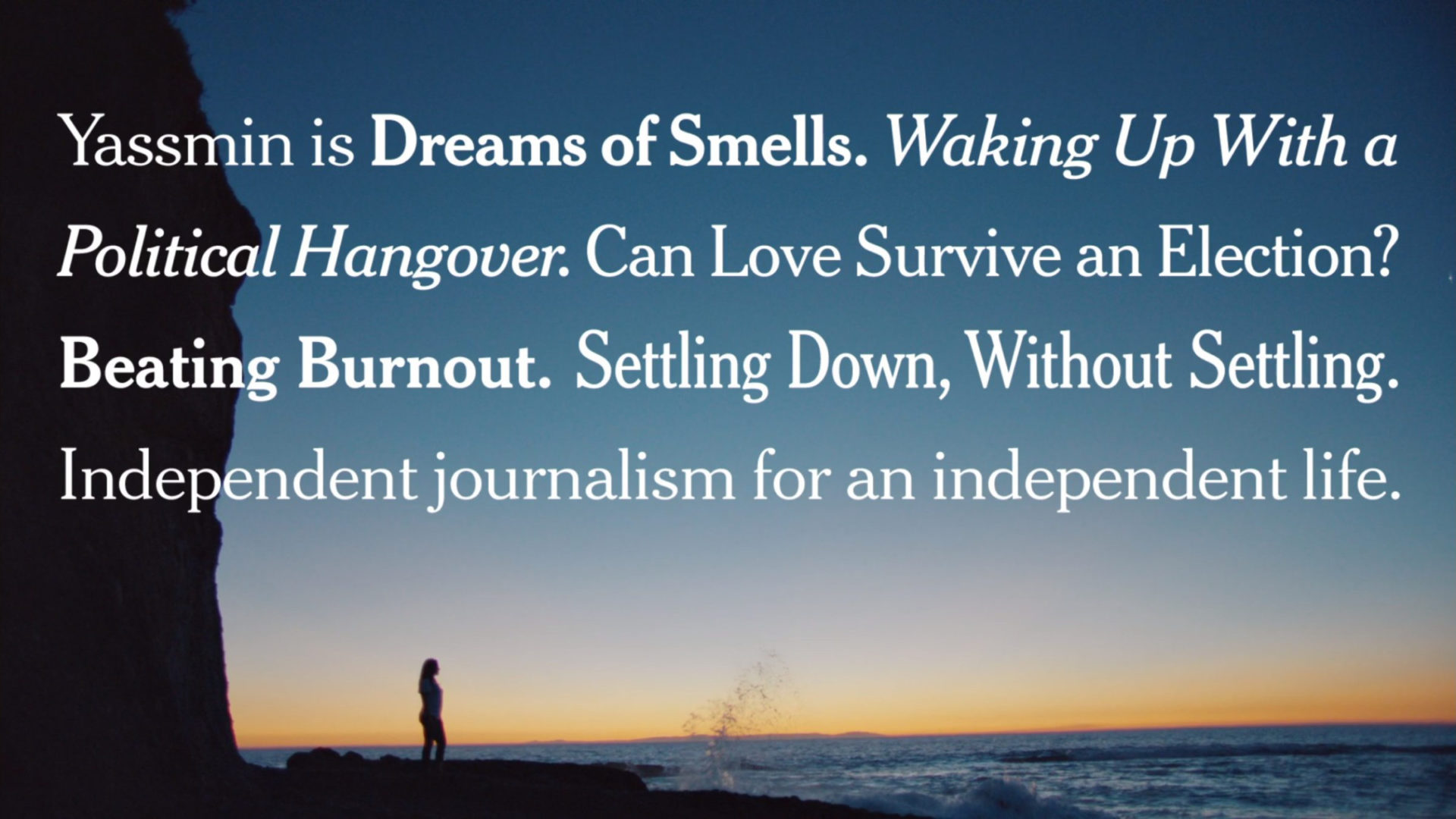
Stewart’s theory of what made Fox News so effective — that it was narrative infotainment for a loyal niche audience — took explicit form in the spin-off show he produced, The Colbert Report. Launching in 2005, it featured former Daily Show correspondent Stephen Colbert in-character as a bombastic conservative pundit, on the model of Fox News personality Bill O’Reilly.
In the premiere episode, Colbert’s character proclaimed himself the emperor of “truthiness.” “We are divided between those who think with their head and those who know with their heart,” he explained. The point was to offer the gentle viewers smug assurance that they still lived in the world of facts while the sheep over at Fox believed whatever felt right.
To illustrate, Colbert used a clip of President George W. Bush defending the nomination of White House Counsel Harriet Miers to the Supreme Court: “I know her heart.” But the quote was actually taken outrageously out of context. The punchline hit big, not because of anything brilliant Colbert had said, but because he understood exactly what his liberal audience already believed about the nomination. In calling out the scourge of truthiness, Colbert was being truthy.
Then again, wasn’t that what Stewart had been doing all along? Wasn’t it even what he promised?
What Stewart insisted on night after night was imposing his own context on the news, a narrative and meaning he decided. He argued that good journalism needed to do this too, that there was no such thing as “objective” journalism because the most powerful decision a journalist could make was to decide what was important.
Wrapped in layers of irony and humor, Stewart had already been relying on truthiness for years, reflecting the incredulity and ire his audience felt about politics and media back to them. The dark secret of Stewart and Colbert’s pastiche of conservative infotainment was that it only worked because their liberal audience wanted the same thing, adjusted for taste. “Anyone can read the news to you. I promise to feel the news at you.”
What Stewart and Colbert didn’t realize was that they were prophets at the advent of what Andrey Mir calls “post-journalism.” The business model of mass-media advertising was dying and subscription-based journalism was rising in its place. The switch in business model would also mean the death of journalism’s old neutrality norms, and the need for new ones. Stewart and Colbert would help pioneer them.
While The Daily Show was helping to kill “spin” in the aughts, online political journalism was also forging a new coin of the realm: a consistent voice, a clear brand, authenticity, telling your audience where you were coming from, and a certain ironic detachment from any particular take. You could make fun of a journalist who posed as objective by exposing him as a partisan hack; it was a lot harder to generate comedy from a pundit doing exactly what you expected a pundit to do.
Out of the advertising cataclysm, there were two newspapers that pivoted in time — and then thrived. The New York Times and The Washington Post managed to substantially grow their revenue by pivoting to a subscription-based model, in everything that entails. In 2020, digital revenue overtook print revenue for the Times, completing its transformation into a self-described “digital-first, subscription-first company.”
Since the new business model does not especially depend on daily newspapers, the Times and Post are free to branch out and develop diverse ways of delivering content, including podcasts, documentaries, and magazines. The primary service provided is interpretation, laying out the puzzles, the narrative, and the clues to the “real” story. A 2017 internal report of the Times’s operations concluded that it spent too many resources on editing and not enough on “story sharpening.” In a 2020 job posting for a new Moscow correspondent, the paper did not require candidates to speak Russian, but did lay out at paragraph length their official storyline about “Vladimir Putin’s Russia.” The Times has doubled its Opinion staff since 2017 while cutting back on traditional shoe-leather desks like local reporting.
Even for the hard reporting that remains, what is really essential under the subscription model is narrative development. Because Stewart and Colbert were right. In the digital age, you really don’t need anyone to read the news to you. What you need is to understand how you should feel about it and what story it tells. For most readers, including many in journalism, the details will simply make no difference in their day-to-day lives. Presented with a massive overload of isolated facts, they will simply want to make sense of them. Helping them do that is the most valuable, and most revenue-generating, function of journalism today.
Finding the most powerful story to build out of carefully collected facts, building a compelling lattice of clips, reports, interviews, and takes that confirm your sense of everything that’s going wrong with the world: More than anyone else, the journalism world today is aping Jon Stewart, the man who figured out how to spin boring, ubiquitous, superabundant media straw into engaging, titillating, persuasive narrative gold.
In his dream, Jon Stewart flees the set of the show cast in his image of journalism: Tucker Carlson Tonight.
Bursting off the stage, he finds himself in a hallway of doors, each leading to a different set where authentic, post-spin, digitally-engaged news analysis can be found. As he runs, he passes by The Rachel Maddow Show, The Joe Rogan Experience, Full Frontal with Samantha Bee, The Lead with Jake Tapper, The Mehdi Hassan Show, Infowars, The ReidOut with Joy Ann Reid, Common Sense with Bari Weiss, and countless others.
Far, far down at the forgotten end of the hall, he stops before a door that reads The Problem with Jon Stewart and pushes through.
On a recent episode of The Problem with Jon Stewart, his new show on Apple TV+, Stewart devoted the whole show to the problems of the mainstream media. It was a rehash of all the old complaints: journalistic narcissism, the 24/7 news cycle, ratings-chasing, and now social media.
On the episode, a half-understanding Stewart listened as Bob Iger, who oversaw ABC News in one form or another for thirty-five years on his climb to being CEO of Disney, explained why the news can’t be fixed. “It’s almost impossible really, today … I don’t think you can create a subscription news service that would generate the kind of revenue you’d need to cover news right.”
But Stewart is still fighting the old fight. He blasts the media’s coverage of the Mueller investigation on the same grounds that critics had once blasted coverage of the Lewinsky affair: that the media had turned it into a TV show. The difference was that the Lewinsky affair was a show almost everyone in America watched, while only a fraction of the populace caught the Mueller show.
And that’s the catch — there isn’t just one big show anymore. And that’s because the market forces that Stewart mastered, the ones that let him take aim at greed, cynicism, and corruption, now let everyone else do the same. Jon Stewart became a Roger Ailes of veracity after all, but instead of everyone watching The Problem with Jon Stewart, hardly anyone is.
In 2003, he had told Bill Moyers that “news has never been objective.” Good reporting is faithful to the facts, but the journalist isn’t afraid to say what’s important — and to decide what’s worth reporting on. And that’s where we’ve arrived today: Nobody is afraid to say what’s important. You cannot sell news today without a point of view.
The tragedy is that this is not a world where that silent broad center of the country is getting the same straight dope. It’s one where everyone gets their own dope, tailor-made.
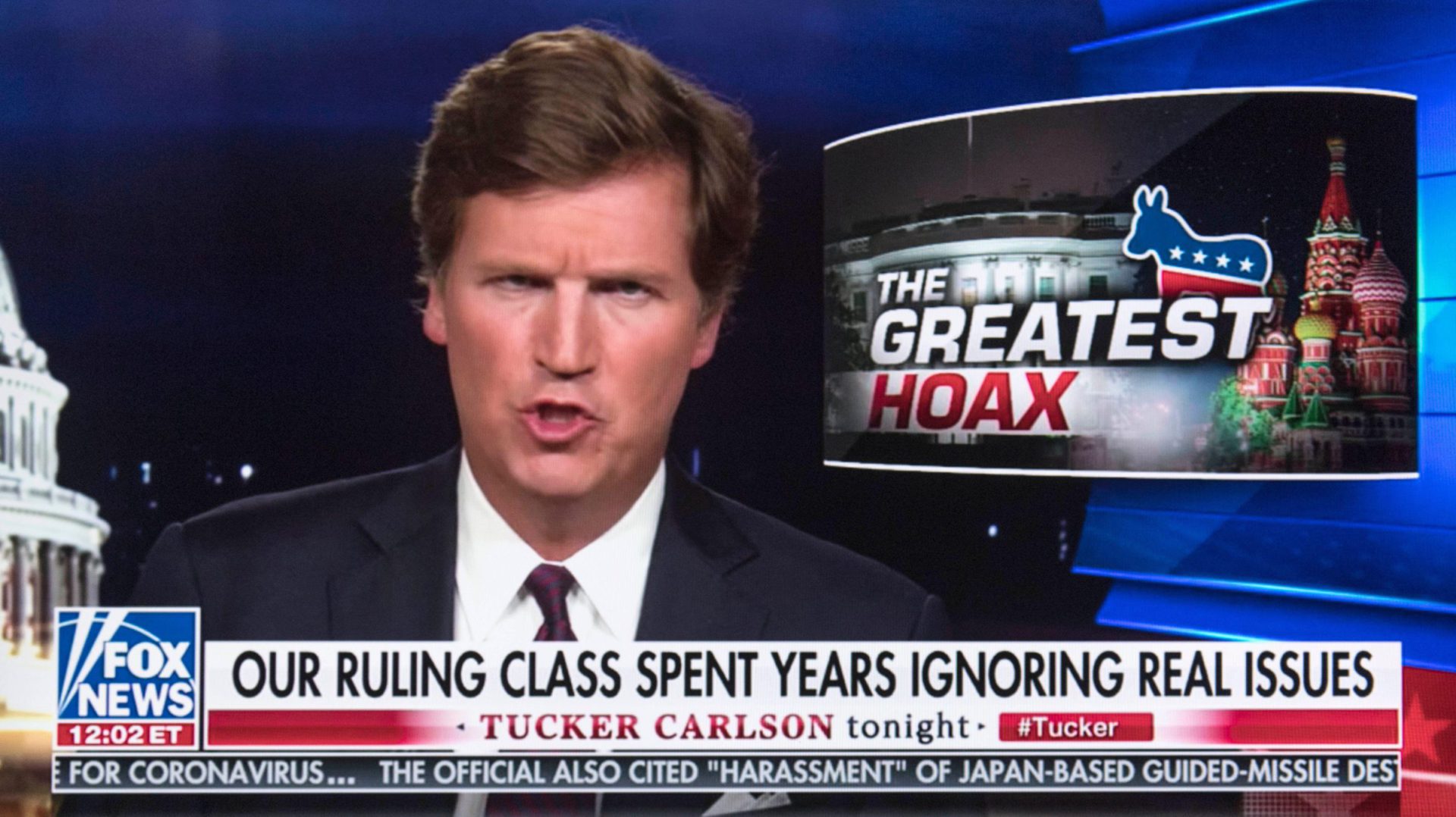
Today there is no central town Coliseum where everyone goes to watch the noble warriors compete. Instead, the landscape has been fractured, walls have gone up, an audience of half a million is now a feat.
And behind each of these walls, the ironies of the Stewart–Colbert project — the free distortion of reality to support the narrative that your foes have lost their grip, the pretense that you’re not doing politics but meta-politics, the delusions that come with believing you’re on a world-historical solo mission to save the American system — still bloom.
The tragedy of Jon Stewart was not that nobody listened to him but that everybody did.
As Stewart blasted away at the establishment in the 2000s, you would think its members would have hated him. But really they loved him. Bill Moyers treated him like a saint. Even poor Jim Cramer called Stewart his “idol,” just hours before his scheduled public evisceration at Stewart’s hand.
And that was because Stewart had the same high view of how journalism used to be that the old-timers did, the same hushed worship of Edward R. Murrow’s raised brow. Stewart spent his whole career railing against television, but he was actually the most nostalgic, backward-looking commentator of them all. You could have imagined a world where, when he finally made his promised serious turn, he just moved on to host a revamped Dateline or 60 Minutes.
That’s the funny thing about Stewart’s Daily Show. It had a reputation for flattering liberal pieties, and of course it did. But the show actually did not have much tangible politics — it mostly didn’t take stands on issues. Instead it was a critique of the form of political journalism that stayed serenely free of its messy content. As The New Republic’s Alex Shephard wrote of the Rally to Restore Sanity, it was “elaborate political theater that nominally appeals to better angels but really signals that liberals are smarter and gentler than conservatives and that, deep down, the rest of the country agrees with them.”
The irony was that in blowtorching TV journalism for having become just about TV, Stewart produced a decade of great TV journalism about … well, TV. The show allowed its audience to stand above the fray, to dodge substantive politics and instead identify with the conviction that they were the ones staying true to the spirit of America while the soulless media-political hacks sold out and the fanatics went off the rails.
Does that sound familiar? As Ross Douthat put it in 2010, he “proved that he can conjure the thrill of a culture war without the costs of combat, and the solidarity of identity politics without any actual politics.” But Douthat was actually describing a different event: Glenn Beck’s Restoring Honor rally, the one that Stewart and Colbert’s rally had aimed to spoof. Many of the ingredients of these dueling rallies — the stick-it-to-the-powers-that-be ethos, the insistence that there was a broad middle of the country who were on the side of the ralliers and against the establishment, even the furious disputes about crowd size — would be echoed a few years later in the rallies to Make America Great Again.
You can flatter your audience over and over every day by showing them proof of how insane the people they despise are becoming. You can tell them what they want to hear about how everyone else is just hearing what they want to hear. You can even build an entire new media business model on this.
But how long can you tell your audience they’re the only ones still living in reality before this idea just becomes an alternate reality of its own?
In 2020, Tucker Carlson Tonight surpassed Hannity to become the highest-rated prime-time cable news show, going on to break the record for highest-rated program in U.S. cable news history. More than any other pundit or comedian, he became the successor in stature and in style of Jon Stewart and Stephen Colbert, whose real lessons he studied better than anyone, and without pretense. Today, journalism is truthiness all the way down.
Carlson hosts hard-hitting interviews, field segments that underline the outrages and absurdities in American life as his audience sees it, and clip compilations that emphasize the show’s underlying themes. He is a master at sifting through masses of information to find the material that shows how hypocritical, foolish, and insane his adversaries are. Just like Stewart, Tucker has the receipts.
He makes no bones about where he’s coming from, routinely exercises editorial authority to highlight stories others have ignored, and takes as valid how his audience feels about the state of the world today, even as he often tries to adjust their understanding of the facts on the margins. His goal, and that of all his lesser imitators: to tell the story of America that weaves a compelling reality for his subscriber community.
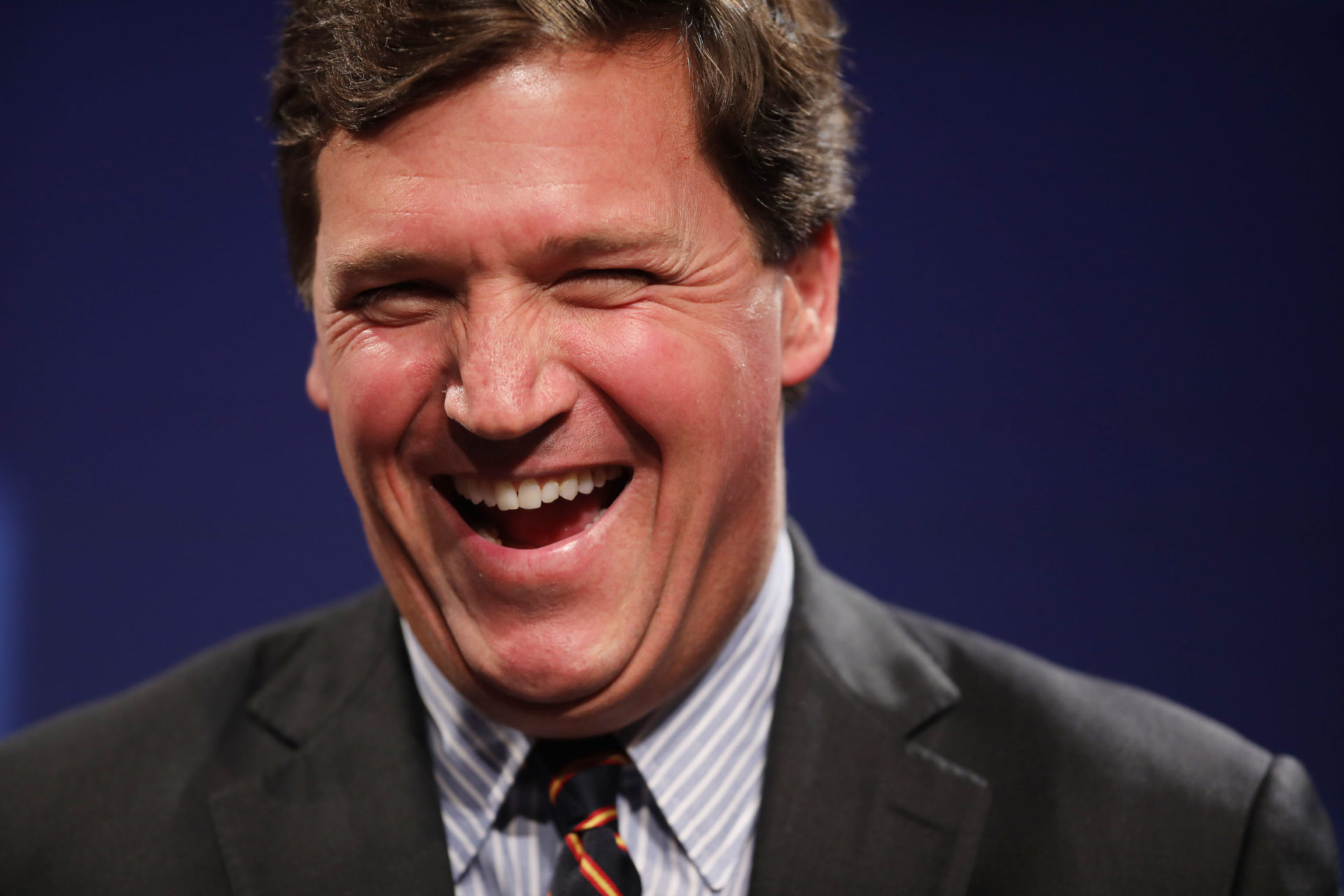
The tragedy of it all is that this isn’t just a nightmare version of the world Jon Stewart dreamed of. It’s a world he built. In his quest to turn real news from the exception into the norm, he pioneered a business model that made it nearly impossible. It’s a model of content production and audience catering perfectly suited to monetize alternate realities delivered to fragmented audiences. It tells us what we want to hear and leaves us with the sense that “they” have departed for fantasy worlds while “we” have our heads on straight. Americans finally have what they didn’t before. The phony theatrics have been destroyed — and replaced not by an earnest new above-the-fray centrism but a more authentic fanaticism.
Jon Stewart pioneered “fake news” in the hope it would deliver us from the absurdities of the old media world. He succeeded beyond his wildest dreams. ♦
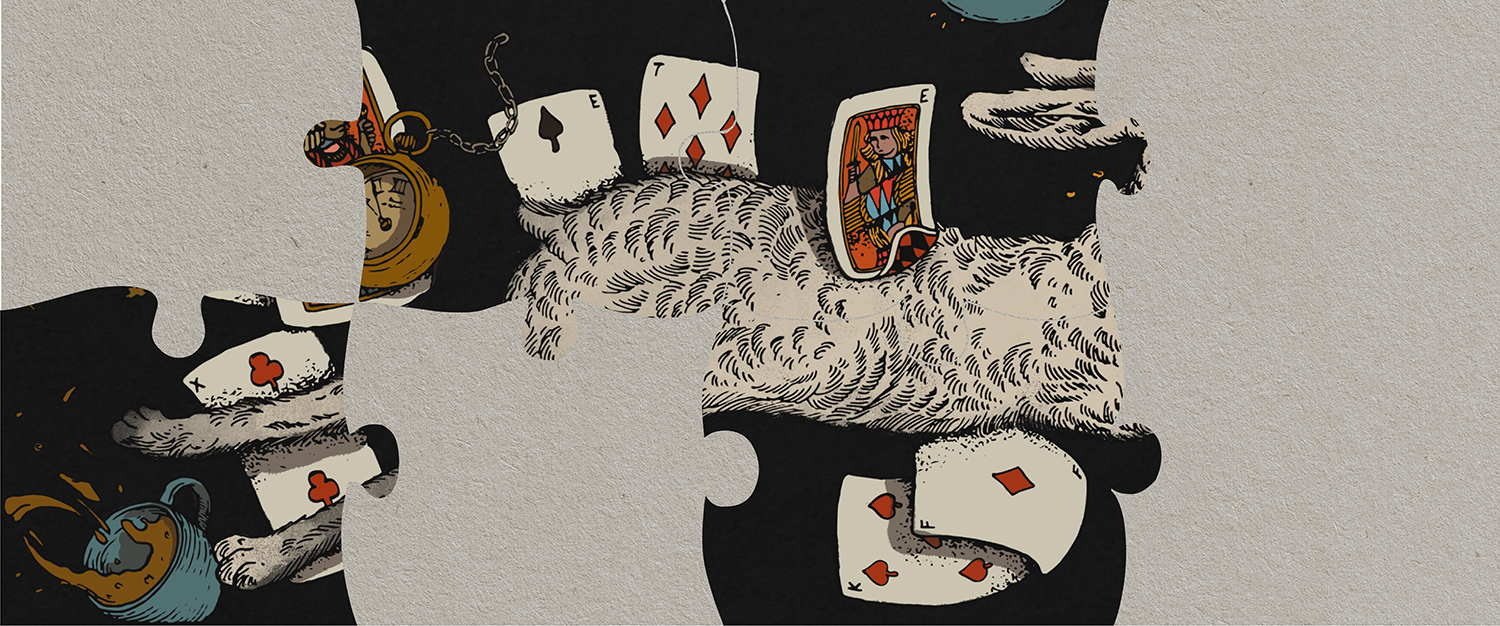
← Essay 2. Reality Is Just a Game Now
Essay 4. What Was the Fact? →